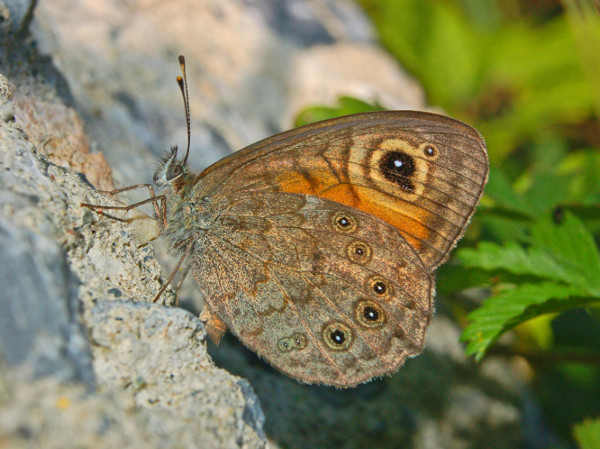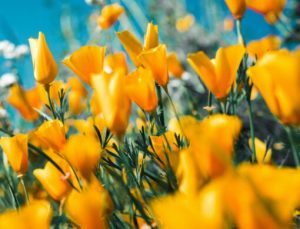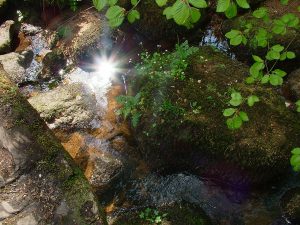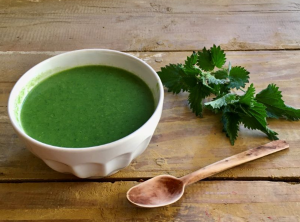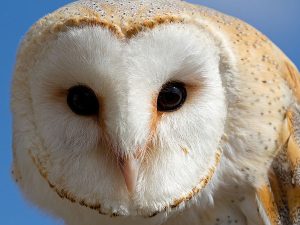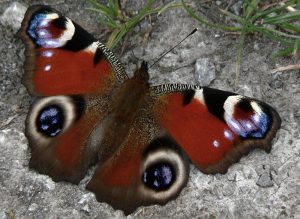Around now I begin to see Speckled Wood and Wall Brown butterflies feeding in the borders or on the buttercups in the cut grass, and by the third week of June, Meadow Browns in the wildflower meadow, with Ringlets joining them in early July.
These butterflies over-winter precariously as tiny caterpillars deep in the cut remnants of our wildflower meadow or long grass around the orchard trees. These grassy areas are only cut in autumn and are then left alone to allow these butterfly species, and plenty of other wildlife, a refuge through the winter. Other grass areas are not cut at all, but left permanently long to accommodate moth larvae and pupae, beetles and a host of other invertebrates, plus small mammals needing a safe place to over-winter. The weather in May and June is important to the Brown butterflies as their tiny caterpillars are feeding and pupating in these months. If the weather is cold and wet, caterpillars and pupae do not always survive, often succumbing to fungal diseases. The Wall Brown is a sedentary butterfly that has declined dramatically. Few people see this species in their gardens unless they live on the coast where species is more likely to be found. This year only one Wall brown has been seen here, feeding on the buttercup flowers that we leave in the lawns. The second brood can be seen feeding later in the year on a variety of garden flowers including Buddleia, Lavender, Cosmos and Knapweed. More often it is living up to its common name by basking in the sun on our house walls! It would be very disappointing to lose this lovely species from our garden, so I am keeping my fingers crossed that there are a couple more around and the individuals of the second brood, which appears here in early August, grace my late summer borders with their beauty.

Recently erroneous comments in the press about the imminent extinction of the Hedgehog in the UK started me thinking about the myths surrounding this lovely mammal – not least the ‘fact’ that they eat masses of slugs and are therefore efficient pest controllers for gardeners. It is difficult to know how this idea arose but as long ago as 1983 the popular book simply called ‘Hedgehog’ by Dr. Pat Morris contained a wonderful graphic representation of the average hedgehog’s diet. It showed that more than three quarters of a hedgehog’s diet is comprised of beetles, caterpillars, earthworms and bird’s eggs. Roughly five percent of their diet is slugs and snails – a very small proportion showing that they are most certainly not the great controllers of slugs that they are supposed to be. However, they will eat slugs when food is scarce and will also eat dead slugs including those poisoned by slugs pellets, so these dangerous chemicals should be avoided in your garden at all costs. But slug pellets are not thought to be the cause of their precipitous decline. Their numbers have plummeted and it is thought that there may be fewer than 1 million left in the UK. It is estimated that in the 1950s there were over 30 million hedgehogs in our gardens and countryside. So what can we do to help these much loved native animals? The key, according to the British Hedgehog Preservation Society and passionate hedgehog ecologist Hugh Warwick is to make sure that our gardens are joined up. One problem hedgehogs have is not enough space to roam and forage – in our towns and cities they need to be able to wander from garden to garden to find food every night, so make sure you have a gap under a fence or gate linking your garden to the one next door, and ask your neighbours to do the same. There may have been erroneous information about hedgehog extinction in the press recently, but that doesn’t mean they don’t need our help. They do, and with that help they can be brought back from the brink.

It was inevitable that with the huge numbers of voles we currently have around in the garden, there would soon be predators. We have become used to seeing a fox from time to time, leaping into the long grass and emerging with a bank vole in its mouth, and also a local kestrel hovering over the wildflower meadow, plummeting down into the vegetation and then flying off with his prize. But I have been keeping my eyes open for both weasels and stoats which we see in the garden here from time to time. Stoats are infrequent visitors, but weasels are seen quite regularly so I wasn’t surprised when I saw a Weasel dashing across the back garden last week and disappearing under a large plant pot which is raised up on bricks and close to a thick hedge. It soon became apparent that this was not a single weasel but a family of four of these little mammals, although one – presumably the parent – was doing all the hunting. I was able to watch this individual for some time, dashing in and out of the hedges and disappearing down vole runs before heading back to the plant container to check on the little ones. These could just be seen chasing each other round and round, and when the adult returned I could hear a short purring or ‘trilling’ noise although it wasn’t possible to tell if this came from the adult or the babies! After a while they all moved off around the garden, following the thick hedges and the alarm calls from the blackbirds and dunnocks gave away their location. By standing as still as I could – camera in hand – I was able to watch the adult racing in and out of the vole runs in the lawn and in the borders, looking for prey. Eventually he or she stood still enough for me to get a decent photograph (seen above), before disappearing back down into the vole runs again to emerge somewhere else. I was fortunate to have such a good view of these amazing and beautiful little creatures, and I am looking forward to catching sight of them again soon around the garden.

Over the past few weeks my Wildflower Meadow has burst forth. That is an interesting phrase but in this context I really understand what it means! Grasses and wildflowers including the ever increasing orchids – everything is bursting upwards and new colours appear every day. If I wander the paths around it I can see butterflies mating, newly emerged damselflies drying their wings, common spotted orchids getting taller by the day (and now over 300 of them from a tiny pinch of seed) plus yellow rattle opening its sunshine-bright flowers. Red clover, ragged robin, plantains and knapweed are all burgeoning. Shrews and voles scuttle about. In short, it looks amazing. But earlier this week I was driven to do something I rarely do any more – I consulted a dictionary. The word I looked up was ‘meadow’ and this was the definition: ‘a tract of grassland, either in its ‘natural’ state or used as pasture or for growing hay’. Personally I would add to that ‘with wildflowers’. But why the interest? After 25 years of making meadows in my own gardens and in other peoples’ I am increasingly tired of coming across companies selling seed to create ‘meadows’ which are simply packets of flower seeds, all mixed together in a big bag. Mostly, they are not even native flowers. But the issue here is not even what the flowers are – it is the lack of grasses. The definition above gets it right! A meadow is usually at least 80% wild grasses and those grass species are crucial to wildlife using this habitat. The grasses are in fact the really important bit. Native grasses are what makes a meadow a meadow, by definition. Those colourful packets of seeds in garden centres and online – some companies even have the word ‘meadow’ in their company name – are simply selling ‘borders’ and not very good ones at that. If you want to scatter handfuls of flower seeds into spaces in your garden you could do it a great deal more cheaply by picking up a few packets of seeds in your local supermarket, and by selecting your own seeds you could choose wisely those that will provide nectar and pollen for pollinators, and maybe even colour-theme your patch if you are really fussy. But if you want a real, lasting habitat in your garden that will benefit huge numbers of invertebrates including bees and butterflies, plus small mammals, amphibians and reptiles and many species of bird, go to the professionals, chose a ‘meadow mix with native grasses’ for your soil type and create something amazing, beautiful and lasting.

It is time for an update on the activities at the Wrens’ Nest in my front porch. I was convinced that this was just an exploratory nest, as male wrens may build more than one and let the female choose her favourite, or which ever she considers to be the most suitable for bringing up her brood. It was therefore a huge surprise to see that she had decided that this was the one she especially liked (there was one other that I knew about in the garden in one of our hedges) as the porch nest is exposed to visitors to the front door, plus my office window looks out directly onto it. This of course is good for me when I am sitting at my desk but not so great for the wren! So it was with some surprise that I noticed wrens coming and going to the nest over the last few days and now one adult which I assume is the female (he is probably off somewhere dallying with another female and another nest) is obviously feeding several young. If I sit on my filing cabinet I have a great view of the nest and I can watch her bringing in food from around the garden, and get a photograph – although only through glass as annoyingly the window is stuck shut. Still, it is amazing to see the range of food she is finding. There are many small, green caterpillars but also crane flies and other small winged insects that even with a photograph I am unable to identify. My observations suggest that she is bringing something on average every ninety seconds plus from time to time she flies off with a faecal sac. She generally feeds from the outside of the nest, but occasionally pops in to do what appears to be a bit of ‘rearranging’ inside. A couple of small beaks appear at the entrance to the nest now and again and I can’t wait to see the little fledglings appearing.

Garden nature in June
Every garden has its daily wildlife – insects, birds or mammals that you tend to see on a regular, though seasonal, basis and then the occasional more unusual visitor will pop up from time to time.
For me the thrill is always a new bird or butterfly, especially if it is something that I have hardly ever seen well before in any habitat. A couple of weeks ago a female Hawfinch appeared here, quietly feeding under a nyjer seed feeder close to the house. The goldfinches which had been feeding have abandoned this area temporarily but there were still plenty of spilled seeds on the bare ground beneath. So together with a couple of female chaffinches, my new visitor hopped nonchalantly about on the ground and the driveway of the house, picking up seeds, before flying off to another part of the garden. Luckily my camera was at hand and I was able to get a few reasonable shots through the kitchen window. This is a bird I had only ever seen way up in the tops of trees, so my garden ‘tick’ was all the more exciting because it was such a great view. A visit to the Forest of Dean some years ago produced that tree-top glimpse but I had long wanted to see hawfinches, especially a splendid male in full breeding plumage. That sight was not to be, but a female hopping around just outside my kitchen was a very special moment. Although obviously not as colourful as the male she was still very handsome and her huge beak was key to her identification. Wildlife in gardens can be unexpected – perhaps once a year I hope to see something new and unusual and an up-close and personal view of a hawfinch was very special. Other unusual birds that have taken refuge in our garden include, woodcock, snipe, lesser spotted woodpecker, willow tit and perhaps most unexpected – a zebra finch!
Do let us know what you can see in nature in June.

